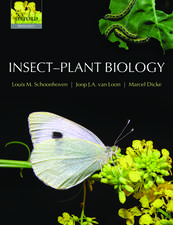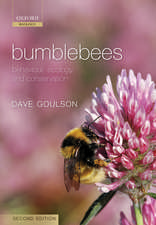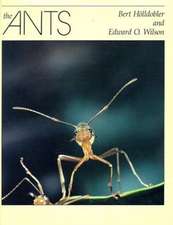Evolutionary Developmental Biology of Invertebrates 2: Lophotrochozoa (Spiralia)
Editat de Andreas Wanningeren Limba Engleză Hardback – 26 aug 2015
This volume covers the animals that have a ciliated larva in their lifecycle (often grouped together as the Lophotrochozoa), as well as the Gnathifera and the Gastrotricha. The interrelationships of these taxa are poorly resolved and a broadly accepted, clade-defining autapomorphy has yet to be defined. Spiral cleavage is sometimes assumed to be the ancestral mode of cleavage of this grouping and therefore the clade is referred to as Spiralia by some authors, although others prefer to extend the term Lophotrochozoa to this entire assemblage. Aside from the taxon-based chapters, this volume includes a chapter that highlights similarities and differences in the processes that underlie regeneration and ontogeny, using the Platyhelminthes as a case study.
| Toate formatele și edițiile | Preț | Express |
|---|---|---|
| Paperback (1) | 367.93 lei 38-45 zile | |
| SPRINGER VIENNA – 23 oct 2016 | 367.93 lei 38-45 zile | |
| Hardback (1) | 399.16 lei 38-45 zile | |
| SPRINGER VIENNA – 26 aug 2015 | 399.16 lei 38-45 zile |
Preț: 399.16 lei
Nou
Puncte Express: 599
Preț estimativ în valută:
76.39€ • 79.65$ • 63.49£
76.39€ • 79.65$ • 63.49£
Carte tipărită la comandă
Livrare economică 17-24 martie
Preluare comenzi: 021 569.72.76
Specificații
ISBN-13: 9783709118702
ISBN-10: 3709118700
Pagini: 300
Ilustrații: VII, 289 p. 102 illus., 90 illus. in color.
Dimensiuni: 178 x 254 x 25 mm
Greutate: 0.92 kg
Ediția:1st ed. 2015
Editura: SPRINGER VIENNA
Colecția Springer
Locul publicării:Vienna, Austria
ISBN-10: 3709118700
Pagini: 300
Ilustrații: VII, 289 p. 102 illus., 90 illus. in color.
Dimensiuni: 178 x 254 x 25 mm
Greutate: 0.92 kg
Ediția:1st ed. 2015
Editura: SPRINGER VIENNA
Colecția Springer
Locul publicării:Vienna, Austria
Public țintă
GraduateCuprins
Gnathifera.- Gastrotricha.- Platyhelminthes.- Regeneration and growth as modes of adult development: The Platyhelminthes as a case study.- Cycliophora.- Entoprocta.- Mollusca.- Nemertea.- Annelida.- Phoronida.-Ectoprocta.- Brachiopoda.
Textul de pe ultima copertă
This multi-author, six-volume work summarizes our current knowledge on the developmental biology of all major invertebrate animal phyla. The main aspects of cleavage, embryogenesis, organogenesis and gene expression are discussed in an evolutionary framework. Each chapter presents an in-depth yet concise overview of both classical and recent literature, supplemented by numerous color illustrations and micrographs of a given animal group. The largely taxon-based chapters are supplemented by essays on topical aspects relevant to modern-day EvoDevo research such as regeneration, embryos in the fossil record, homology in the age of genomics and the role of EvoDevo in the context of reconstructing evolutionary and phylogenetic scenarios. A list of open questions at the end of each chapter may serve as a source of inspiration for the next generation of EvoDevo scientists. Evolutionary Developmental Biology of Invertebrates is a must-have for any scientist, teacher or student interested in developmental and evolutionary biology as well as in general invertebrate zoology.
This volume covers the animals that have a ciliated larva in their lifecycle (often grouped together as the Lophotrochozoa), as well as the Gnathifera and the Gastrotricha. The interrelationships of these taxa are poorly resolved and a broadly accepted, clade-defining autapomorphy has yet to be defined. Spiral cleavage is sometimes assumed to be the ancestral mode of cleavage of this grouping and therefore the clade is referred to as Spiralia by some authors, although others prefer to extend the term Lophotrochozoa to this entire assemblage. Aside from the taxon-based chapters, this volume includes a chapter that highlights similarities and differences in the processes that underlie regeneration and ontogeny, using the Platyhelminthes as a case study.
This volume covers the animals that have a ciliated larva in their lifecycle (often grouped together as the Lophotrochozoa), as well as the Gnathifera and the Gastrotricha. The interrelationships of these taxa are poorly resolved and a broadly accepted, clade-defining autapomorphy has yet to be defined. Spiral cleavage is sometimes assumed to be the ancestral mode of cleavage of this grouping and therefore the clade is referred to as Spiralia by some authors, although others prefer to extend the term Lophotrochozoa to this entire assemblage. Aside from the taxon-based chapters, this volume includes a chapter that highlights similarities and differences in the processes that underlie regeneration and ontogeny, using the Platyhelminthes as a case study.
Caracteristici
First book specifically describing invertebrate non-model organisms Written by designated experts in the respective areas Richly illustrated and easy-to-understand















